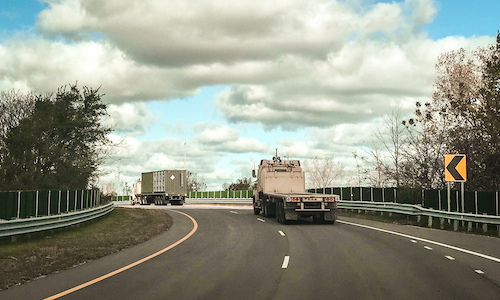
With all the recent news about autonomous vehicles, it’s easy to start feeling like your next (or at least next-next) car might be driving you around. But UM-Dearborn faculty Sridhar Lakshmanan and Paul Richardson both agree that it’s probably best to keep your expectations in check for now.
Richardson, chair and professor of electrical and computer engineering, said without hesitation that on the “crawl-walk-run” scale of progress, we’re still mostly using all fours to get around. Vehicle system safety and robustness are still the biggest overall issues. He said everyday conditions like mud, ice, snow and rain are still enough to cause sensor data to be interpreted incorrectly. And autonomous cars offer a challenging value proposition for automakers. “Due to the developmental investment, the initial cost of autonomous vehicles is likely to be prohibitively high,” Richardson said.
That said, autonomous vehicle technology could be more of a near-future possibility in other parts of the transportation space. For example, Lakshmanan and Richardson currently are working on a project in conjunction with Auburn University and the U.S. Army that could transform the way long-haul trucks move across the country.
It centers on an idea called truck platooning, in which a caravan of autonomous trucks would follow a leader truck operated by a human driver. For the human truck driver at the head of the pack, it’s pretty much business as usual. But what happens behind is a pretty cool game of high-tech follow the leader. Using vehicle control systems designed by Auburn and truck-to-truck communications systems built by UM-Dearborn, three autonomous trucks follow behind in a single file line, each reacting to what’s happening in front of them. For example, if the lead human driver brakes or speeds up, her truck sends a radio message to the others of the change of plan so they can all maintain the set spacing of 50 meters.
The autonomous trucks can even react to spontaneous highway events. Say a car cuts in between a couple autonomous members of the platoon: The vehicles can automatically drop back to leave a safe distance for the interloping driver and then close the gap after the driver exits the platoon. That’s a trick the trucks pulled off, in fact, during a recent March test run when the team took the platoon out on some metro Detroit freeways — their first time on the open road.
As a technical problem, Lakshmanan said a platoon like this is substantially less complicated than designing a fully autonomous vehicle.
“Imagine a truck with nobody to collaborate with and no driver: That truck has to do everything a truck driver has to do in terms of assimilating the world,” said Lakshmanan, associate professor of electrical and computer engineering. “Whereas with a convoy, we’re relying on the skilled human operator to do the more difficult work, and the autonomous vehicles are doing what they’re good at — which is more or less following a line.”
The fact that the trucks can talk to each other makes this leader-follower relationship even easier to coordinate. When the follower truck puts on the brakes in reaction to the leader slowing down, it’s not because the follower had to independently perceive that change and then decide how to react. It’s because the leader truck automatically “told” the follower what was going on.
The value proposition of this technology is also healthier, due to a couple major real-world challenges now impacting the trucking industry. First, by tightening the gaps between vehicles (a feat that connected vehicles are good at), trucks in the convoy can draft off each other. Even at a distance of 50 meters, the fuel savings is about 12 percent. Close the gap to 50 feet, and that shoots up to 20 percent. And when you consider that fuel represents about a third of the industry’s overall costs, that’s a big deal.
The other factor: Trucking is facing a labor crisis. In 2018, the state of Indiana alone had a estimated shortage of 50,000 drivers. So in this space, the robots might not be taking our jobs so much as doing jobs that humans are less interested in doing.
Richardson said the trucking industry is in fact already moving in this direction.
“There are companies now that do ‘matchmaking’ between long-haul truckers. If two drivers are heading in the same direction, they’ll team up somewhere along the route so they can draft off each other,” he said. Those trucks — like his autonomous platoon trucks — are even equipped with an adaptive cruise control that allows them to automatically maintain a set drafting distance.
Richardson said leader-follower systems like this — but where the followers become autonomous — could be part of the near future, especially for long stretches of open road in the middle part of the country. In that scenario, human truck drivers might become short-haul drivers: That is, they’d specialize in moving goods from and through tricky urban areas to the cross-country straightaways, where the robots could then do more of the work. That could potentially improve quality of work life for human drivers, too, whose work would no longer take them so far from home.
And regardless, Richardson said human drivers’ jobs are plenty safe for now. “Driving a convoy like ours through a dense urban area or even pulling into a crowded truck stop for refueling — we’re just not there yet,” he said.
But with promising new research like this, we might not be crawling for long.





